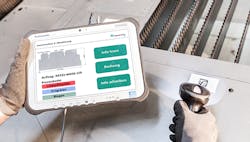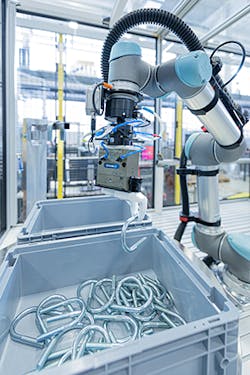Industrial robotics receive room to grow at Fraunhofer IPA
Dr. Werner Kraus is head of the Robot and Assistive Systems department at Fraunhofer Institute for Manufacturing Engineering and Automation IPA in Stuttgart, Germany.
Tell us about your organization’s state-of-the-art robotics technology?
Dr. Werner Kraus, head of the Robot and Assistive Systems department, Fraunhofer Institute for Manufacturing Engineering and Automation IPA: Fraunhofer is a research organization with a strong focus on technology transfer. The organization in total has more than 29,000 employees and more than 70 institutes. Here at the Fraunhofer Institute for Manufacturing Engineering and Automation IPA in Stuttgart, Germany, around 100 scientists develop software and hardware technology for innovative robot systems (Figure 1). That is why it is hard to mention one state-of-the-art robotics technology. In general, we do research to offer the most innovative and efficient solutions with robots, be they in industrial applications, such as handling, welding or assembly, or to support humans with so-called service robots that work for example in logistics, health care or agriculture.
Also read: Autonomous mobile robots’ value is more than just speed
A very important topic for us is the field of cognitive robotics. The vision behind this is the “automation of automation.” The robots of the future will be networked, able to act and react as cyber-physical systems; thanks to sensors and actuators, they will enable versatile production and be more intuitive to use than before. They will require less explicit programming but will understand implicitly what they have to do and how they solve a problem. Artificial Intelligence and machine learning in particular will play a key role here. As a result, robot operation will require less expert robot knowledge. Especially with decreasing batch sizes in mechanical and plant engineering, robots can thus be reprogrammed more quickly and used economically.
Figure 2: Bin-picking robots can use end effectors to pick up and sort different objects from a box.
What have been the biggest improvements to robotics technology in the past five years?
Dr. Werner Kraus, head of the Robot and Assistive Systems department, Fraunhofer Institute for Manufacturing Engineering and Automation IPA: I guess it is the combination of machine learning (ML) with robots. Machine learning is the subfield of artificial intelligence (AI) that is currently being applied and researched the most. Particular attention is being paid here to deep learning—deep neural networks. Thanks to the intelligent use of data, they have the potential to provide an enormous boost to productivity and innovation, not only but especially in robotics. Machine learning is currently attracting a huge amount of attention and will remain one of the most influential technologies in industry for the near future.
In robotics, machine learning is both promising but also challenging because robots interact with a wide variety of environments and training data is very expensive to obtain or scarce. Simulation will play a key role here. In unstructured environments, such as the home or warehouse, humans are still about three to five times faster than robots, and robots also require extensive programming by experts. In the future, AI will enable robots to independently solve tasks set by humans and achieve human-like execution speeds.
What’s the most innovative or efficient robotics technology application you’ve ever seen or been involved with?
Dr. Werner Kraus, head of the Robot and Assistive Systems department, Fraunhofer Institute for Manufacturing Engineering and Automation IPA: In 2015, the Tübingen-based Max Planck Institute for Biological Cybernetics and Fraunhofer IPA co-developed a cable-driven parallel robot. It was the first cable robot system capable of transporting humans while also setting new standards for a motion simulator in terms of workspace, acceleration and payload. With 348 kW drive performance it reaches accelerations of up to 1.5 g.
End effectors of cable robots can be freely moved with high accuracy by up to eight cables and winches. In the cable-driven simulator, the motion of the cabin is controlled by eight steel cables attached to winches. This reduces the moving mass, and the workspace can be scaled to any size. As a result, the simulator is used for virtual-reality applications like driving or flight simulations, but also to neurologically study motion perception processes with humans.
Cable robotics has always been a very exciting topic for me. Around the same time when the cable-drive simulator was developed, I worked as a research fellow at Fraunhofer IPA and wrote my PhD thesis on the force control of cable-driven parallel robots. These cable robots have more cables than degrees-of-freedom of the platform and therefore belong to the class of redundant robots. This allows tensing the cables against each other. In my thesis, I proposed a control approach to synchronously control the platform position and the cable forces.
How has robotics technology benefitted from remote monitoring and connectivity?
Dr. Werner Kraus, head of the Robot and Assistive Systems department, Fraunhofer Institute for Manufacturing Engineering and Automation IPA: A good example is the IPA spinoff NODE navigation. Resulting from research at Fraunhofer IPA, NODE offers plug-and-play software solutions for autonomous intralogistics. The focus is on driverless transport vehicles and mobile robots, which are turned into multi-vendor, autonomous and collaborative fleets. The software solutions provide the basis for the widespread use of autonomous mobile robots (AMRs) in production and intralogistics. For example, the German car manufacturer BMW already deploys more than 400 AMRs with the NODE navigation. Smart fleet management and a shared map of the manufacturing plant ensure the connectivity. The robots can also connect via cloud. Remote monitoring plays a vital role: Experts can perform remote ramp-up support and analysis with the recorded data of the AMR.
Can you explain how software development has changed robotics technology design and production?
Dr. Werner Kraus, head of the Robot and Assistive Systems department, Fraunhofer Institute for Manufacturing Engineering and Automation IPA: I have seen significant changes with the increasing use of open-source software. The robotic operating system (ROS) is all open-source and helps experts and do-it-yourself (DIY) amateurs to build their robot applications. It consists of a set of software libraries and tools such as drivers or state-of-the-art algorithms. Using ROS really speeds up the development process. As ROS uses permissive open-source licenses, it is easy to combine with closed-source software. Broad knowledge is linked into the software project like open CV, point cloud library or Moveit for trajectory planning.
How do robotics technologies figure into digital-twin platform models being used by manufacturers?
Dr. Werner Kraus, head of the Robot and Assistive Systems department, Fraunhofer Institute for Manufacturing Engineering and Automation IPA: A digital twin can be very important when it comes to robot programing. Real-life data for training robots can be very expensive to obtain. Therefore, we often work with simulations, for example, for skill training in the field of assembly. We also develop technologies for bin picking, where the robot can pick up and sort different objects from a box (Figure 2). A real-life training would be very time-consuming, which is why we use a physics simulation to prepare the robot.
When will robotics technology become IT-friendly enough that engineers are no longer required for installation and operation?
Dr. Werner Kraus, head of the Robot and Assistive Systems department, Fraunhofer Institute for Manufacturing Engineering and Automation IPA: This is a development which has already begun. Robots are penetrating more and more applications. There are still conventional robots that, once programmed by experts, repeat the same motion sequence over many years. However, there are plenty of opportunities and requirements for new applications where hard-coded robot fail due to changing environments or work pieces. Therefore, programming is becoming more important. Since, for example, reprogramming is often necessary due to small batch sizes or product variants, simple and fast programming is the key for a cost-efficient use of robots. If only experts could continue to do this, the time and cost involved would be very high, comparable to waiting for a craftsman. This need is giving rise to the democratization of robotics. This means that even non-experts would like or even have to be able to program robots. The role models are smartphones and tablets, which have raised high expectations in terms of intuitive operation.
In my opinion, such programming should offer a quick sense of achievement and enable the implementation of creative ideas. Best practice is a graphical user interface. In addition, so-called skills are used: These are small function blocks that you can simply select and put together a robot program from them. No knowledge of a programming language is required because the code is hidden behind the skills. For example, a skill can control a screw-driving process. It is also conducive to learning success if the robot programming can be adapted to the different levels of expertise of the user, making the robot a loyal companion on the journey to becoming a robot expert, so to speak.
However, I see a danger in intuitive programming interfaces where the programming tool could limit the robot to simple standard tasks and thus its potential could not be exploited. It is therefore important that open programming is also possible. This means that, if necessary and with the appropriate programming skills, an expert can for example use special commands to get the last bit of performance out of the robot.
Here at Fraunhofer IPA we are developing a variety of user-friendly programming solutions. Examples are our spin-off drag&bot or the IT platform xito.
What future innovations will impact the use of robotics technology in discrete-manufacturing operations?
Dr. Werner Kraus, head of the Robot and Assistive Systems department, Fraunhofer Institute for Manufacturing Engineering and Automation IPA: Robots used to be perfect for mass production. Once set up, they could perform repetitive tasks over and over again, up to several decades. However, low-mix, high-volume (LMHV) is not the future anymore. With the increasing trend toward personalization companies, now need to produce in high-mix, low-volume (HMLV). This individualization needs efficient programming and reconfiguration. Automated processes become infeasible due to tremendous manual efforts for each variant. Automation of automation is an innovation which makes robotics economically feasible for HMLV and therefore will definitely impact the use of robotics technology in the future.
Here at Fraunhofer IPA we are also working at modular matrix assembly systems. They consist of freely interlinking stations and offer an alternative assembly structure in a volatile environment. The matrix provides new degrees of freedom when it comes to designing, planning and controlling assembly systems. We have developed specific planning methods to design and convert classical systems as a matrix while taking into account individual conditions.
Autonomous mobile robots will definitely change the whole production process. For years, many companies have already been employing driverless transport systems. But those vehicles are not interacting; they only know how to stay in their lane and drive from one point to another. AMRs know how to navigate autonomously. They can avoid collisions and figure out the fastest way. This will significantly improve the flow of material, therefore speed up and simplify productions.
Another point is that human-robot collaboration (HRC) could save thousands of assembly jobs across Europe. However, cost-effective robot assistants for assembly workstations have been in short supply so far. When robotic cells are installed in the assembly hall, they either have often been provided with too few safety precautions and thus violate applicable regulations. Then they have to be retrofitted accordingly. Or far too many precautions have been taken. In both cases, unnecessary costs are incurred. To avoid these from the outset, experts at Fraunhofer IPA have developed the Computer-Aided Risk Assessment. A software program checks the computer model of a planned robot cell for possible hazards, lists them in a table and informs about suitable safety measures.
Last but not least, robots are learning how to configure themselves. This can be a huge advantage for example in logistics, where they have to deal with many different work pieces. In almost all areas of production, bulk goods are utilized. The various work pieces are transported loosely in boxes and processed at different stations. For this, they need to be picked up and set down in a specific place. This task still tends to be carried out manually. To automate this task, software has been developed at Fraunhofer IPA which is capable of locating work pieces in a bin, thus enabling a robot to pick them up. The position of the parts is identified using an efficient algorithm based on the respective CAD model and machine learning methods and can be implemented for almost any component.
About the Author
Mike Bacidore
Editor in Chief
Mike Bacidore is chief editor of Control Design and has been an integral part of the Endeavor Business Media editorial team since 2007. Previously, he was editorial director at Hughes Communications and a portfolio manager of the human resources and labor law areas at Wolters Kluwer. Bacidore holds a BA from the University of Illinois and an MBA from Lake Forest Graduate School of Management. He is an award-winning columnist, earning multiple regional and national awards from the American Society of Business Publication Editors. He may be reached at [email protected]

Leaders relevant to this article:



